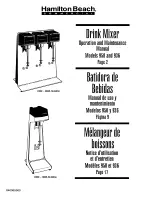
X.200 Digital Production Console
FAQ
8
Q. Does the Digital X Bus support the use of PACE® iLok?
A. Yes. You can download the latest PACE Interlok (iLok) drivers from the PACE web site (http://www.paceap.com)
and install them on the Digital X Bus. Then, you simply load your plug-ins accordingly, insert your iLok into one of
the USB ports on the Digital X bus, and run the respective third party authorization application.
Q. Can I run freeware VSTs on the X.200?
A. The use of freeware VST plug-ins is completely at the risk of the user. Mackie does not offi cially support any free-
ware VST plug-ins. However, you are able to load them into the console and use them at your own risk. We cannot
guarantee the mixer will work to proper specifi cation if any un-authorized freeware VSTs are loaded and/or running.
Q. If I decide to accept the risk, how do I load and use freeware VST plug-ins inside the Digital X Bus?
A. Most freeware VSTs are simply downloaded from the Internet as a compressed/zipped fi le, within which is a “.dll”
fi le for the actual plug-in. The only fi le you will need for the Digital X Bus is the .dll fi le. Any other fi les, such as
a “ReadMe.txt” fi le or anything similar, will be useless in the mixer because the Digital X Bus does not have any
ancillary programs, such as Microsoft™ Word™ or Notepad™, installed. Therefore, you will not be able to open
them in the mixer.
Once you have the .dll fi les, you need to copy them into the “D:\FreewareVST” folder on the Digital X Bus’ internal
hard drive. Simply copy the freeware .dll fi les to your USB Flash Drive, insert that Flash Drive into one of the USB
ports on the back of the Digital X Bus, open the Digital X Bus File Manager (under the File Menu), locate the fi les
on your USB Flash Drive, and copy them to the D:\FreewareVST folder.
Once you have copied those fi les to the X.200, you need to re-boot the mixer so it can re-scan that directory and
make those plug-ins available to use within the Effects Rack.
Q. Does the X.200 provide ADC (Automatic Delay Compensation)?
A. The Digital X Bus software uses a manual delay compensation setting to allow you to align your clean and pro-
cessed channels together. Each channel delay has a maximum setting of 500 ms. Additionally, channel delays can
be set very easily by selecting the channel that is suffering the delay, and offsetting all other channels by a certain
amount with a single command.
We are aware that ADC is preferable for VST host applications, and we are looking into the possibility of adding
automatic delay compensation into a future version of the Digital X Bus software.
Q. Can I use the “DelayComp” plug-in to offset any latencies resulting from use of the UAD-1 plug-ins?
A. Yes. The Digital X Bus works just like a regular VST host in that regard. You can assign the UAD-1 DelayComp
plug-in on channels adjacent to channels going through UAD-1 processors, and offset the delay by up to eight
instances of those plug-ins. Please refer to the UAD-1 product documentation for full information on the use of the
DelayComp plug-in.
Q. Will the X.200 support the TC Powercore and/or FireCore in addition to the UAD-1?
A. With the current confi guration, the TC Powercore card is physically too large to be installed in the Digital X Bus.
And because the FireWire I/O Option Card for the X.200 is a FireWire device and not a host, it cannot be connected
directly to the TC FireCore. However, the X.200 has been tested with and can run the TC Native Bundle VST plug-ins.






























